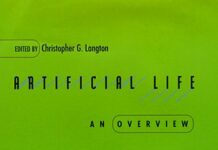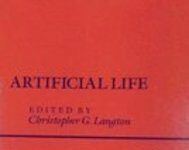
Ebook Info
- Published: 2003
- Number of pages: 880 pages
- Format: PDF
- File Size: 39.80 MB
- Authors: Christopher G. Langton
Description
Artificial life is a new field of scientific inquiry that studies biology by attempting to synthesize such biological phenomena as life, evolution, and ecological dynamics within computers and other “artificial” media. In addition to uncovering new ways to study life as we know it, a life extends research to the larger domain of life as it could be, whatever it might be made of and wherever it might be found in the universe.This proceedings volume, based on the second artificial life workshop held in Santa Fe, New Mexico, 1990, reflects the evolution and horizons of this rich field of study, and builds on the proceedings of the seminal first workshop, held at Los Alamos in 1987 (also available from Addison Wesley). This compendium includes more than 30 papers spanning the spectrum of a-life research, from studies of the origin of life to models of complex systems.
User’s Reviews
Reviews from Amazon users which were colected at the time this book was published on the website:
⭐provided as advertised
⭐This sounds like hyperbole, but I believe this was the most important book of the decade. I don’t think anyone has ever assembled an anthology in any subject with so many seminal, groundbreaking new works (the articles by Kaufmann, Ray, Langton, Hillis, Koza, & Bagley). The proceedings of the first conference, published in 1989, are still worth reading, but were still embryonic: more cheerleading and blind groping for topics of study, less math.You reasonably ask, then, 25 years later, where is their impact? There has been none, yet. This book was the most important book in creating the discipline of studying how life and ecosystems work at the holistic, computational level. Our molecular tools are now fine enough that we could begin to apply this in biology, but the climate at the NIH, which will not give grants for projects with computationalists in charge, has so far prevented that from happening. The approach could be useful in economics, but there is no funding for research in economics.
⭐If you are intrested in how biological systems can be simulated via computer or in what contect computer programs or computer simulations can be called alive — this is the book to read.Eventhou the articials in this book are technical reports from a scientific conference most provide easy reading for the layperson.Artificial Life is a fassinating scientific endevor that seeks to do for biology what Artificial Instelligence did for psychology — model biological processes, instead of mental processes on the computer and look to biology as a model for computation — using techniques such as Genetic Algorithms, Cellular Automata and Neural Networks.I find that all the books I’ve read that were published by the Santa Fe Institute to be intresting — how ever the Artifical Life series is the easiest for an armchair scientist to grasp.
⭐
Keywords
Free Download Artificial Life II (SANTA FE INSTITUTE STUDIES IN THE SCIENCES OF COMPLEXITY PROCEEDINGS) in PDF format
Artificial Life II (SANTA FE INSTITUTE STUDIES IN THE SCIENCES OF COMPLEXITY PROCEEDINGS) PDF Free Download
Download Artificial Life II (SANTA FE INSTITUTE STUDIES IN THE SCIENCES OF COMPLEXITY PROCEEDINGS) 2003 PDF Free
Artificial Life II (SANTA FE INSTITUTE STUDIES IN THE SCIENCES OF COMPLEXITY PROCEEDINGS) 2003 PDF Free Download
Download Artificial Life II (SANTA FE INSTITUTE STUDIES IN THE SCIENCES OF COMPLEXITY PROCEEDINGS) PDF
Free Download Ebook Artificial Life II (SANTA FE INSTITUTE STUDIES IN THE SCIENCES OF COMPLEXITY PROCEEDINGS)

